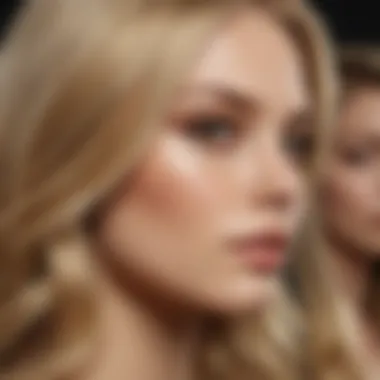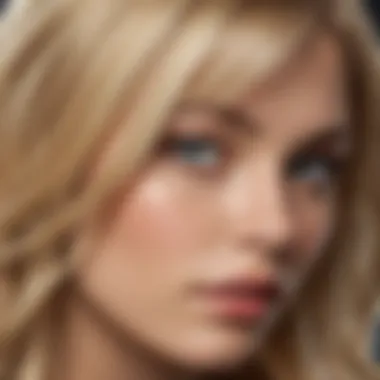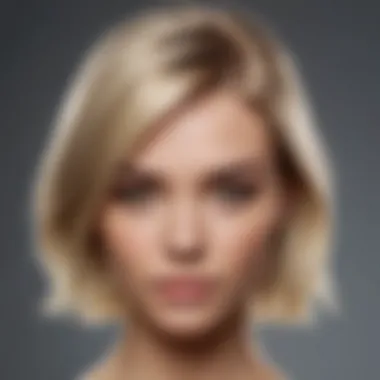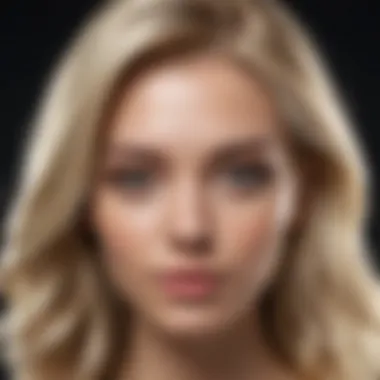Exploring the Spectrum of Blonde Hair: Types and Care


Intro
Blonde hair is more than just a color; it’s a statement. It encapsulates a spectrum of shades, each one as unique as the person who wears it. Understanding the different types of blonde—from platinum to honey, ash to strawberry—requires a keen eye and an appreciation for the nuances that each shade brings to an individual's look. In this exploration, we dive deep into the kaleidoscope of blonde hair, dissecting not only the variations in hues but also the proper care techniques necessary to maintain their vibrancy and shine. Furthermore, we’ll catch the breeze of current trends and the shifting perceptions of blonde in different cultures, shedding light on how this hair color can serve as a canvas for personal expression.
For beauty enthusiasts, makeup lovers, and skincare aficionados, unlocking the secrets of blonde hair isn't just about picking a shade; it's about embracing a lifestyle. This guide offers a roadmap to navigate through the delicate balance of choosing the right shade for your complexion, maintaining it with effective care routines, and staying on top of the latest trends. Whether you're a long-time blonde or just dipping your toes into the lighter shades, there’s something here for everyone.
"Blonde hair may be the essence of summer, but it requires year-round dedication to look its best."
As we journey through the palette of blonde hair, we will share beauty tips and tricks tailored specifically for maintaining and enhancing your natural glow. With product reviews, makeup trends, expert advice, and some tidbits from the beauty industry, this article gives you the tools to not just wear blonde hair, but to own it.
Understanding Blonde Hair
Blonde hair isn’t just a color; it’s a cultural statement, an expression of individuality, and in many ways, a canvas for creativity. Getting to grips with the diverse types of blonde hair is paramount, especially when considering how personal shade selection can impact one's overall look. This knowledge allows individuals to tailor their appearance, ensuring it resonates with their unique personality while considering their skin tone and eye color.
Observing how different blonde hues reflect light and interact with skin tones can be as intricate as a dance. Understanding these dynamics is essential. By diving into the specifics of blonde hair, someone can elevate their hair game, selecting shades that aren’t just trendy but complementary.
The Science of Hair Color
At the heart of blonde hair science lies a substance called melanin. Hair color is determined by two types of melanin: eumelanin, which appears brown to black, and pheomelanin, which appears yellow to red. The ratio of these pigments will dictate whether a person ends up with blonde, brown, or even red hair.
Interestingly, blonde hair contains lower levels of eumelanin compared to darker shades. So, it’s like a balance of pigments in a seesaw; the more pheomelanin that’s present, the lighter the hair tends to be. Blonde shades, ranging from icy platinum to warm honey, result from varying amounts of these two melanin types in the hair.
Key Factors Influencing Hair Color:
- Genetics: The inherited traits dictate the color and texture of hair from generation to generation.
- Environment: Sun exposure can lighten hair over time, adding natural highlights.
- Chemicals: Hair products can affect the color and overall health of hair.
Genetics and Hair Color Variations
Genetics play an essential role in the spectrum of blonde shades a person can possess. Certain genes, like the MC1R gene, are responsible for the production of melanin and can lead to a range of hair colors, including those beautiful golden tones.
The variations in blonde hair aren’t just about looks; they tell stories of ancestry and heritage. In some cultures, blonde hair has been revered, while in others, it has been shunned. This historical context adds layers to how blonde hair is perceived today.
Fascinating Genetic Facts:
- Variability: Genetic combinations can result in unique shades that you may not expect.
- Recessive Traits: Sometimes, blonde hair can show up in individuals even if their parents have darker hair due to recessive genes at play.
- Natural Lightening: As people age, natural blonde hair can turn darker or even gray, showcasing the beauty of evolution in hair color through different life stages.
In summation, blonde hair, from its scientific background to its genetic variability, is a compelling topic that not only affects personal aesthetics but also resonates deeply with cultural narratives. Understanding these elements can truly empower your choices regarding hair care, color treatments, and self-expression.
Classic Blonde Shades
Classic blonde shades represent a timeless palette that continues to resonate with many individuals seeking to express their personality through hair color. Acknowledging this spectrum not only enriches the understanding of blonde hair but also allows potential wearers to choose shades that harmonize with their unique features.
The diversity within classic shades such as platinum, golden, strawberry, and dirty blonde offers something for almost everyone. Each shade brings its own character, making them more than just colors but rather extensions of identity, style, and lifestyle. This section will break down these shades while exploring their distinctive qualities, maintenance tips, and who might suit each tone best.
Platinum Blonde
Platinum blonde stands out as the brightest of the classic shades. Its strikingly light tone often draws attention and admiration. This shade is characterized by its almost white appearance, offering a vivid contrast against darker skin tones. Platinum can enhance features, making them pop, particularly on individuals with blue or gray eyes.
However, achieving platinum requires a careful process of bleaching and toning, demanding proper hair care afterward. Use a purple shampoo once or twice a week to maintain the brightness and avoid brassiness. Frequent conditioning treatments also help keep the hair healthy.
"To bear platinum is to wear confidence. It’s not just a color; it's a statement."
Golden Blonde
Golden blonde encapsulates warmth and richness, reminiscent of sun-kissed hair after a summer day. It’s a versatile shade that flatters a variety of skin tones, especially those with golden or olive undertones. The golden hue shines through in sunlight, embracing a more natural feel compared to the more dramatic platinum.


This shade is easier to maintain than platinum, but it does require some attention to keep it radiant. Avoid over-washing, as that can strip the hair of natural oils. Instead, aim for a balance of moisture and cleanliness.
Strawberry Blonde
Strawberry blonde might not be the first shade that comes to mind in discussions about blonds, but it holds a captivating place. This combination of blonde and red hues is perfect for those who wish to channel a bit of fun without going too far from traditional blonde.
It's ideal for individuals with fair skin, as the warm tones can complement rosy cheeks beautifully. Strawberry blondes often experience a unique challenge with upkeep, particularly to keep the vibrancy of red tones intact. A color-safe shampoo can help maintain the integrity of the shade.
Dirty Blonde
Dirty blonde serves as a beautiful middle ground, blending darker and lighter hues seamlessly. It's a practical choice for those who want blonde without the commitment of regular touch-ups associated with lighter blonde shades. Dirty blonde can range from a light tan to a darker shade that leans towards brown.
This color is especially forgiving and can add depth to hair, making it a popular choice for those wanting a more understated appearance. A good treatment once a week can help maintain shine and softness, preventing the hair from looking dull or lifeless.
In summary, each shade offers its own set of qualities, benefits, and maintenance challenges. Choosing a classic blonde shade depends on various factors, from skin tone to personal style preferences. Understanding these nuances ensures a more informed and fulfilling hair color choice.
Ash Blonde Variations
The world of ash blonde variations stands as a testament to the versatility and nuances that blonde hair can encompass. These shades bridge the divide between light and dark, offering a middle ground that many find appealing. Ash blonde isn’t just a color; it’s a vibe, a statement, and, sometimes, a way to embrace individuality while still fitting into numerous aesthetic categories. By understanding the different tones of ash blonde, readers can appreciate how these unique shades can enhance their overall look and style.
Ash blonde shades come into play when talking about hair care and maintenance, too. They often require specific products and care routines to maintain their cool tones, preventing that dreaded brassy appearance. As people now lean towards more natural looks, understanding these variations becomes critical for anyone aiming to navigate the blonde spectrum.
Cool Ash Blonde
Cool ash blonde is often classified as a neutral to slightly grayish tone, making it an ideal choice for those who want to avoid warmer undertones found in traditional blonde shades. This shade is perfect for fair skin tones with pink or bluish undertones, allowing for a striking contrast that can catch the light in captivating ways.
Choosing cool ash blonde can often be a double-edged sword. On one side, its sophisticated vibe can set you apart in any crowd. On the other side, maintaining its icy brilliance requires commitment to a solid hair care routine. It’s usually advisable to invest in sulfate-free shampoos and conditioners specifically designed for cool tones.
Additionally, incorporating purple toning shampoos can significantly help to neutralize any unwanted warmth that might creep in over time.
Beige Blonde
The allure of beige blonde lies in its unique blend of warmth and coolness, making it accessible for a variety of skin tones. Beige blonde infuses some golden notes without straying too far into warmth, allowing for an understated, chic look.
What sets beige blonde apart is its compatibility. It harmonizes beautifully with various complexions, from light to medium. This shade is particularly forgiving; it doesn’t scream for attention yet stands out subtly. For maintenance, it often requires less frequent touch-ups than other shades, which is a godsend for those who lead busy lives.
Considering beige blonde as an option also opens the door to a plethora of styling choices. From weaving in highlights to keeping it solid, the choices are plenty, and that flexibility can be refreshing in the world of hair color.
Mushroom Blonde
Mushroom blonde is an intriguing option that blends earthy tones with ashy highlights. Suitable for those wishing to embrace a more grounded look, it features shades of soft brown intermingled with cooler blonde hues.
This color often appeals to darker-haired individuals looking to transition into blonde without making a drastic leap. By incorporating mushroom blonde into one’s style, the result can be striking yet understated, much like a whisper rather than a shout.
Maintaining the integrity of mushroom blonde can be less demanding than its lighter counterparts. Products that assist in keeping the color vibrant while treating the hair gently are essential. A replenishing conditioner can go a long way in preserving that balance between texture and hue.
"Choosing the right shade of ash blonde is less about following trends and more about finding what makes you feel confident and radiant."
In summary, the spectrum of ash blonde variations highlights the diverse options available for those wanting to explore this appealing hair color. By grasping the distinct characteristics, maintenance needs, and stylistic opportunities that come with each shade, individuals can make informed decisions that align deep with their self-expression in today’s fashion landscape.
Highlighting Techniques
Highlighting techniques play a crucial role in enhancing the versatility and appeal of blonde hair. They allow individuals to create depth and dimension, which can elevate a simple cut into a work of art. Highlighting is not merely about changing hair color but about sculpting the hair to embrace one’s unique features. When applied correctly, highlights can frame the face, soften features, and even add an illusion of movement and texture.
In the world of blonde hair, highlighting brings various benefits. These include:
- Enhanced Natural Beauty: Highlights can complement skin tones and eye colors, making features pop in a subtle yet impactful way.
- Low Maintenance: Many techniques grow out beautifully, meaning less frequent touch-ups.
- Customizable Looks: Depending on one’s preference and aesthetic goals, techniques can vary from bold and striking to soft and blended, ensuring there's something for everyone.


Before choosing any technique, it’s wise to consider:
- The current shade of hair, as this influences how highlights will appear.
- The desired end effect, whether it’s a sun-kissed glow or a more dramatic contrast.
Understanding these elements will aid in decision-making when it comes to blonde hair highlights.
Balayage
Balayage is often referred to as an art form in hair coloring. This technique involves painting highlights onto the hair in a way that mimics the natural lightening caused by the sun. The word "balayage" comes from the French term meaning "to sweep," and that’s exactly what the stylists do: they sweep color onto sections of hair, creating a soft and blended effect.
One of the greatest advantages of balayage is its ability to work with nearly all hair types and lengths. For blondes, this method creates a multidimensional effect that can look effortlessly chic. It's particularly well-suited for those who seek a softer, more natural look without the commitment of constant upkeep.
However, it’s essential to consult a professional. Achieving the perfect balayage requires a keen eye and skillful hands to ensure that the highlights blend well while avoiding harsh lines or overly uniform colors.
Foil Highlights
Foil highlights are the classic approach for achieving bright, striking highlights. In this method, small sections of hair are wrapped in foil after being coated with a lightening agent. This technique allows for precision and uniformity, making it a favored choice for many blondes seeking a bolder change.
The use of foil increases the heat around the hair shaft, which can enhance the lightening process. This technology is incredibly effective for those wanting vibrant, contrasted colors that make a statement. Additionally, foil highlights can be tailored to various styles, from finely woven strands to chunky sections.
Despite their vibrant results, this method can be more demanding in terms of maintenance. Regular touch-ups are necessary to keep the look fresh, and it’s advisable to discuss a personalized hair care routine to maintain healthy blonde locks.
Ombre and Sombré
Ombre and sombré techniques represent two styles that cater to those looking for an interesting color transition. Ombre, which showcases a gradient effect from dark to light, often sees deep roots transitioning to a brighter blonde on the tips. The look can be both bold and dramatic, often attracting those who wish to showcase their personality through their hair.
On the other hand, sombré is a softer take on ombre, producing a subtler, more blended transition. It maintains the darker roots but offers a lightened effect that is elegant and understated. The advantage of sombré is its wearability; it tends to require less maintenance while integrating seamlessly into hair growth.
Using these two techniques, one can create a highly customized blonde experience. Both ombre and sombré can highlight facial features wonderfully, presenting a playful yet sophisticated flair in any setting.
"Whether you go for bold or subtle, highlighting techniques are all about playing up your unique beauty as you shine."
Choosing the Right Blonde
Selecting the right shade of blonde can feel like searching for a needle in a haystack. With so many options available, understanding how to match blonde hair to your individual features is crucial. This decision goes beyond mere color; it can impact how your overall appearance resonates with others. A well-chosen shade of blonde can illuminate your complexion, enhance your natural features, and create a harmonious look that can turn heads.
When it comes to blonde hair, there are two pivotal aspects to consider: skin tone and eye color. Both are fundamental in determining which shade will not only look good but will also make you feel confident.
So, let's break it down.
Skin Tone Considerations
Your skin tone serves as a foundational element in determining the right shade of blonde. Whether your skin has warm, cool, or neutral undertones significantly influences which hues complement you best.
- Warm Undertones: If your skin tends to have golden, peachy, or olive notes, shades like golden blonde or honey blonde are your best friends. These colors will work harmoniously with your warm radiance, creating a balanced and vibrant look.
- Cool Undertones: For those with lighter, pinkish, or bluish undertones, cool shades of blonde such as platinum or ash blonde are more suitable. These hues can enhance the natural coolness of your complexion without overwhelming it.
- Neutral Undertones: If you have a mix of warm and cool undertones, consider versatile shades like beige blonde or light caramel. These colors can adapt well to your skin's natural nuances, offering a balanced aesthetic.
"Understanding your undertone is pivotal; it can mean the difference between looking radiant or washed out."
Fitting the right blonde with your skin tone isn’t just about aesthetics; it can boost your self-esteem and allow you to express your identity better.
Eye Color Pairing
Equally important in this quest for the perfect blonde is eye color. This aspect can create an eye-catching synergy that elevates your entire look. Different shades of blonde can enhance the eye color and draw attention. Here’s how to align your blonde with your eye color:
- Blue Eyes: Light, icy blondes can make blue eyes pop, creating a striking contrast. Shades like platinum or cool ash blonde provide a visual sharpness that draws interest.
- Green Eyes: If you have green eyes, consider warm blonde tones such as golden blonde or even strawberry blonde. These options can bring out the warmth and vibrancy of your eye color.
- Brown Eyes: For brown-eyed beauties, caramel blonde can enrich the depth of your eyes, giving a soft, warm effect. Dark blonde shades can also create a beautiful harmony with brown eyes, providing a smooth transition from hair to eye.
- Hazel Eyes: Depending on the fluctuation of hues in hazel, you can play with a range of shades—from golden to ash blonde. Experimenting here can yield stunning results, as hazel can feature both warm and cool tones.


Cultural Perspectives on Blonde Hair
Blonde hair occupies a unique space in cultural narratives, symbolizing various traits, ideals, and trends through the ages. In this section, we delve into how societies perceive blonde hair, its historical significance, and the ways it has been represented in modern media. Understanding these cultural nuances helps shine a light on the pervasive influence of blonde hair in our lives and the beauty industry, as well as the inherent biases and stereotypes that come with it.
Historical Context
Historically, blonde hair has been associated with a certain allure and desirability. Ancient civilizations viewed it through different lenses—while the Greeks celebrated it, referring to certain fair-haired people as "golden-haired", early Christians often connected it to purity. This duality is fascinating, as it reflects society's evolving perceptions of beauty. For instance, during the Renaissance, paintings featured blondes as paragons of virtue and serenity, often representing divine beauty. On the flip side, by the 19th century, blonde hair started becoming entwined with the ideal of "The Aryan Race," leading to troubling associations that still echo in some communities today.
Today, discussions on cultural appropriation often touch on how different cultures celebrate or critique blonde hair, reflecting power dynamics that span racial, social, and economic contexts. For some individuals, going blonde can feel like a means of assimilation, whereas others boldly rock blonde shades to assert their identity. This complexity makes the historical narrative of blonde hair rich and layered.
Modern Representations in Media
From the golden locks of Marilyn Monroe to the icy strands of Taylor Swift, blonde hair remains a recurring motif in film, television, and advertising—a double-edged sword, serving both empowerment and perpetuation of stereotypes. Icons of pop culture have often portrayed blonde women as the quintessential beauty, embodying innocence, charm, and, unfortunately, sometimes a lack of intellect. This stereotype—often referred to as the "dumb blonde" trope—has been criticized extensively, raising awareness around the dangerous implications it has on societal perceptions.
On the brighter side of things, recent years have seen a push for more diverse representations of blonde-haired individuals. Shows like Game of Thrones and characters such as Daenerys Targaryen present blondes as strong, complex figures, moving the narrative away from superficiality. The rise of social media has democratized the space further, allowing influencers and stylists to showcase the versatility and vibrance of blonde hair across different demographics.
"Blonde hair stories are not just about color; they reflect broader themes of identity, confidence, and cultural dynamics."
This shift indicates a growing understanding that blonde hair exists across various backgrounds and that beauty can be multifaceted, transcending narrow definitions. The spotlight now shines on the personal stories behind each individual�’s choice to sport blonde hair, demonstrating how these choices resonate with their unique backgrounds and aspirations.
Care and Maintenance of Blonde Hair
Caring for blonde hair is essential to maintain its vitality and vibrancy. When hair is bleached or colored, it can become susceptible to damage, dryness, and fading. This makes proper maintenance and care imperative, especially for those sporting lighter shades. A comprehensive understanding of how to nurture blonde hair can greatly enhance its appearance and longevity.
While many might assume that all hair types require the same care, this couldn't be farther from the truth. Blonde hair often undergoes treatments that can strip natural oils and nutrients. Therefore, what works for brunette or red hair may not suffice for blonde locks. Investing time and effort into high-quality products and routines pays off with beautiful, healthy blonde hair.
Shampoos and Conditioners
Selecting the right shampoo and conditioner is crucial for blonde hair. Not only do these products cleanse and moisturize, but they also help to prevent brassiness and enhance shine. Here are several tips:
- Sulfate-free formulas: These products are gentler and do not strip the hair of its natural oils. Sulfates can exacerbate dryness, making hair more prone to breakage.
- Purple shampoo: For maintaining that fresh, cool blonde hue, purple shampoo works wonders. The pigments neutralize yellow tones, giving hair a brighter appearance.
- Moisturizing conditioners: Choose conditioners that are rich in oils, proteins, and nutrients. They are essential for replenishing what was lost during bleaching and drying processes.
Treatments for Damage Control
Even the most carefully colored blonde hair can face daily aggression from environmental factors and heat styling. Hence, incorporating specialized treatments becomes non-negotiable. Here are effective strategies to combat damage:
- Deep conditioning treatments: Using a deep conditioner or a hair mask once a week can help revive dry, brittle strands. Look for ingredients like keratin and argan oil, which can nourish and strengthen hair.
- Leave-in conditioners: Utilizing a leave-in product can provide added moisture and protection throughout the day. It acts as a barrier against environmental elements.
- Split-end serums: These serums seal split ends and prevent further damage. By applying them on the ends of the hair, it can give a polished look, making hair appear healthier and more vibrant.
"The best way to keep your blonde looking fresh and fabulous is to make care a part of your routine. A little extra attention goes a long way!"
In summary, maintaining blonde hair hinges on understanding its unique needs. From the right shampoos and conditioners to targeted treatments, the right choices can help ensure that each strand remains luminous and resilient.
Trends in Blonding Techniques
Blonde hair has long been a symbol of beauty, versatility, and personal expression. In recent years, the landscape of blonding has evolved significantly, bringing forth trends that help individuals embrace their unique styles. These trends are not just about aesthetics; they also reflect a growing awareness of sustainability and innovation in hair care products. Let’s unpack what’s shaping the current state of blonding techniques.
Sustainable Practices in Hair Care
The push towards sustainability in beauty has reached the hair industry with ample force. Sustainable practices in hair care encompass a variety of strategies aimed at minimizing environmental impact while maximizing the health of our hair. In this era, more and more salons are turning to eco-friendly products that contain naturally derived ingredients, avoiding harmful chemicals that can deteriorate not just hair but also our ecosystems.
- Biodegradable Products: Many brands have begun to offer shampoos and conditioners that are packaged in biodegradable materials, allowing consumers to reduce plastic waste.
- Plant-Based Dyes: Natural hair dyes derived from plants are becoming increasingly popular. These dyes often result in stunning shades without the harsh chemicals, offering a gentler alternative for the hair and scalp.
- Water-Saving Techniques: Some salons are adopting methods that use less water during the coloring process, addressing one of the larger environmental concerns we face today.
- Community Involvement: Beauty brands are now more than ever involved in community efforts to promote sustainability, often collaborating with local artisans or fundraisers aimed at environmental causes.
"Sustainability in hair care is not just a trend; it's a responsibility we all share to care for our planet while looking good."
Overall, these sustainable practices not only aim at preserving our environment, but they also promote healthier hair in the long-run.
Innovations in Coloring Products
The landscape of hair coloring has transformed dramatically. Innovations in coloring products continue to emerge, making the process safer and more effective than ever before. Here are a few noteworthy advancements:
- Ammonia-Free Dyes: Traditional dyes often contained ammonia, which could be irritating. Now, many brands are offering ammonia-free options, allowing for a more pleasant experience. These dyes provide beautiful results without sacrificing hair health.
- Technology in Color Matching: Advances in technology have made it possible for color matching algorithms to assist stylists in achieving the ideal shade, tailoring to individual preferences and skin tones.
- Color Depositing Treatments: These new treatments allow individuals to deposit color without the commitment of a full dye job. They can refresh and enhance existing blondes, offering a temporary boost that fades gracefully.
- Long-Lasting Treatments: Innovations have also led to treatments designed to lock in color longer while providing essential hydration. These products often incorporate bonding technologies that protect the hair structure.
Navigating the myriad of products available can feel overwhelming, but keeping an eye on these innovations is essential for anyone looking to maintain their blonde locks in top shape. They facilitate not just a change in color but also contribute to overall hair health, demonstrating a new age in beauty where efficacy meets ethics.







